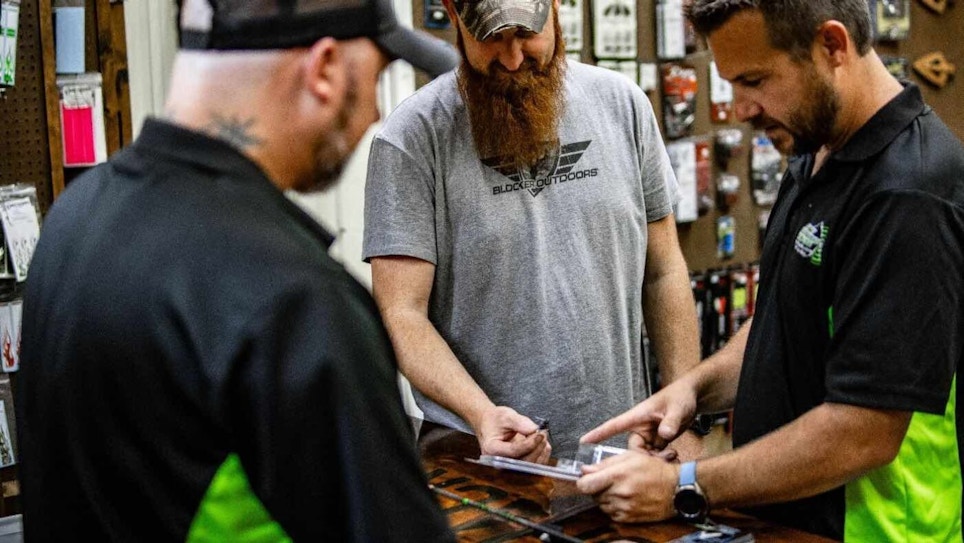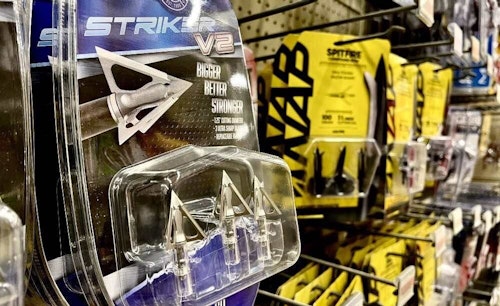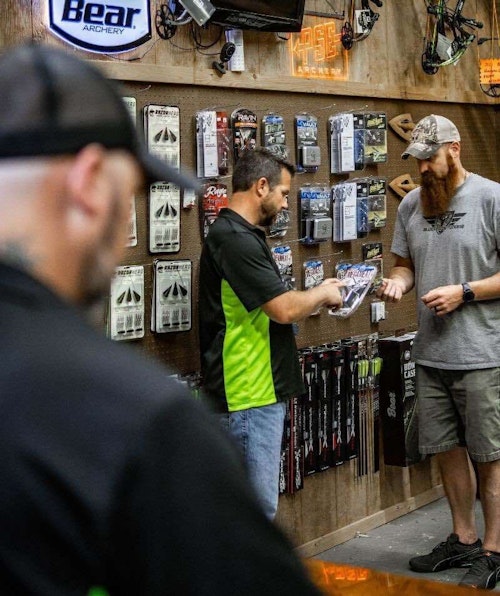
You’re the expert, and undecided customers will seek your opinions. That’s why shop owner Jeremy Cheek (right) did a broadhead test at The Archeryshack. He keeps all broadheads from the test in a small container so that customers can see how each one survived the test. (Photo courtesy of The Archeryshack)
While perusing the 2023 ATA Show app, I glanced through the “Points & Broadheads” category. I counted nearly 60 exhibitors. Granted, some sell only target tips or other arrow components, but my best guess is that at least 40 on the list are in the broadhead business. And, I can think of some broadhead manufacturers that aren’t listed in the app, too.
So, let’s just say that 40 companies are selling broadheads, and that each company has three models — we all know that most have more than three. This would mean there are north of 120 different broadhead models to choose from, and there are many more than that in reality. This obviously presents archery retailers with quite a dilemma. I mean, you can’t stock 40 different broadhead brands nor have 120-plus broadhead SKUs on your pegs; you’d be drowning in broadheads.
For dealers that have been in business longer than 25 years, the number of manufacturers has probably tripled, maybe even quadrupled. In other words, the landscape has changed drastically and made merchandise purchasing a more complex undertaking. Broadheads make up a fast-growing category that’s nearly impossible to stay on top of.
Whether you’re a new dealer or you’ve simply become lost in all of the options, this article is designed to help you make sense of the broadhead conglomeration. Along with my knowledge of the industry and the broadhead category, I also took the time to visit with Jeremy Cheek of The Archeryshack in Anderson, South Carolina, and John Schaffer of Schaffer Performance Archery in Burnsville, Minnesota. The two provided solid insights into their approaches to retailing broadheads. Below are some highlights from those discussions.

Brands and What to Look For
With the plethora of brands available, stocking only three or four isn’t the right answer, but neither is 33 or even 23. Finding some middle ground is a good approach. For The Archeryshack, 10-12 brands are the magic numbers.
“A handful of them are tried-and-true brands that are popular year after year,” Cheek said. “Another three or four models are ones that have gained traction more recently. From there, we pay attention to trends. A lot can be learned online, but we also have customers come in and request something specific. We often start out conservatively when we purchase a new broadhead, and if it really takes off, then we’ll order a bunch more.
“One example of a recent trend is when some YouTube influencers began pushing cut-on-contact fixed-blade heads. We had folks coming in left and right asking for Magnus Broadheads, so we ramped up our Magnus stock. Another trend was around the G5 Outdoors Megameat mechanical. I don’t know how G5 was advertising and all of that, but we sold tons of those heads.”
Schaffer didn’t get too tied up in discussing the number of brands a shop should stock. Instead, he detailed what he specifically seeks in a broadhead manufacturer.
“We choose brands based on a combination of things,” he said. “First, we have to like and believe in the product ourselves. We really gravitate toward USA-made stuff. We really like dealer-only items with good margins, and above all, we don’t want our customers to come back and yell at us about the broadheads that we sold them.”

Fixed-Blades vs. Mechanicals
Perhaps the most common debate in modern archery is fixed-blade vs. mechanical broadheads. Everyone has their opinion, and no matter your geographic location, you can expect there to be demand for both.
“You have to stock both,” Schaffer suggested. “In our store, preference has gone back and forth a few times over the years. For the last several years now, fixed-blade heads outsell expendables in our store, which is a result of what we personally use and suggest when customers ask. In talking with them, we explain it in very simple terms. With a mechanical, you get a larger hole with less penetration, and with a fixed blade, you get more penetration with a smaller hole. They can decide from there what’s more important.”
Cheek talked through the selling scenario when a customer is loyal to neither side.
“Typically, when someone undecided comes in, we guide them through the decision by sharing which broadheads we’re currently using, as well as ones we’ve used in the past and have had success with,” he explained. “Customers love knowing that we have experience with the broadheads that we offer.
“We did some broadhead testing last year and the year before that for our YouTube channel. It wasn’t scientific or anything fancy, but we shot a bunch of different heads through wood and also at a sharp angle into a target to test for deflection. We kept all of the broadheads after they were shot through a wooden pallet, and we have all of them in a case by the broadhead display. Customers can see how each broadhead held up and make their decision based on the results.”
Fixed-blade broadheads have been around for a very long time, and fundamentally, they haven’t changed; the concept is that the blades create a cutting diameter that doesn’t change. But, the construction and attributes set apart the best ones from the rest.
“Most customers want to re-sharpen their broadheads,” Cheek said, “so we’ve seen a big surge of interest around the solid one-piece heads such as G5’s Montec. In the past, we rarely sold broadhead sharpeners. We’d have one or two in stock, and they’d take forever to sell. Things have changed; we’ve sold several dozen sharpeners just in the last couple of years.
“I don’t want to sell fix-blade broadheads that are junk after one or two shots. I look for something with a super-strong ferrule that either has changeable blades or blades that can be re-sharpened. We also want to offer heads with sharp blades right out of the package. During our test, we took rubber bands and ran them across the blades. With a couple of them, we were basically hacksawing the rubber band with the blades and they wouldn’t cut the band. Sharpness is important. It’s nice to be able to tell a customer that a head is very sharp right out of the package.”
Schaffer has several options in his store, but one specific model that checks all of the boxes is the most popular. “We have a fixed-blade head made specially for us by Wasp,” he detailed. “We call it the Drone S. It’s a 1-inch all-steel head. It’s by far our best-seller.”
On the mechanical side, there are many different variations, and deployment style seems to be the swaying factor for consumers. Of course, that preference varies by region, as Cheek’s and Schaffer’s opposing observations depict.
“Of the market’s different types of mechanicals, the rear-deploying designs are the most popular in our store and have been for the last few years,” Cheek said. “We also offer a few jackknife-deploying designs that some people have been shooting for years and are partial to. They’re slowly becoming less popular, though.”
Schaffer reported the opposite. “On the expandable side, we sell more Grim Reapers than any other,” he said. “We do very well with their Pro Series heads. Most customers prefer the jackknife-style blade deployment. We do have some expendables with rear-deploying blades, too, but we’ve had fewer complaints with the jackknife-style models from Grim Reaper than any of the others.”

Price Points
Broadhead prices have changed extensively during the past 20 years. A three-pack of Rocket expendables retailed for $24.99 in the early 2000s. Today, most three-packs of reputable broadheads are at least $50 MSRP.
“Surprisingly, we’ve heard nearly no complaints about the price increases,” Cheek said. “Plenty of people are shooting Iron Will heads, which are about $120 for a three-pack, and they don’t think twice about it. Most broadheads we offer are $50-60 for a three-pack, and my customers — even the low- and mid-priced bow buyers — aren’t concerned about it. If anyone hesitates, we’re prepared to explain the differences between what we sell and the $25 three-packs sold at box stores. Our customers trust our opinions and almost always buy from us.”
Contrastingly, Schaffer said that pricing complaints are fairly common. “Customers complain, sure, but there aren’t any significant options that are cheaper,” he said. “So, there isn’t anything they or we can do about it. It’s just a casualty of the times, I guess.”
To that end, let box stores sell the cheap stuff. As a pro shop, maintain your standards. Quality comes at a price, and most of your customers will understand your lingo when you explain why the broadheads you sell are more expensive than those at the local box store.
Final Thoughts
Broadheads are a bowhunting necessity, so there aren’t a lot of different ways to increase sales via merchandising displays. The best thing you can do is keep them in a static location and organize them in a way that customers can easily decipher.
“We don’t really do anything special with displaying our broadheads,” Cheek said. “We basically organize them by brand. It’s pretty easy for the customer to see what we all have, but we try to talk with them and ask a few questions to learn what exactly they’re after. Then, we can point them in the right direction faster.
“If someone comes in dead set on a particular broadhead, we don’t try to talk them into something different unless we’ve had a poor experience with it. This is where the little plastic box with all of the heads we tested through wood comes in handy. We can tell the customer what we did with each head and show them how it held up.”
That’s about all. To summarize, there are way more broadhead makes and models than a single store can offer and sell. Start with a manageable number and add or subtract as you track how each brand and SKU sells. Be an expert in your field and use/test what you sell.
Points such as “dealer-exclusive” or “USA-made” go a long way. Offer a selection of both fixed-blade and mechanical heads. With mechanicals, pay attention to which deployment style your customers prefer most, and then increase your stock of said options. These efforts will help you to make sense of the broadhead conglomeration.
Sidebar: Specialty Broadheads
Aside from fixed-blade and mechanical broadheads, there are two other types that I want to discuss: turkey head-shot broadheads, and hybrids with both fixed and mechanical blades. Cheek and Schaffer weighed in.
“Turkey head-shot broadheads were very popular about 6-8 years ago, and we sold a ton of them,” Cheek said. “But, interest in them has plummeted. We still have a few packs on the wall, but we haven’t sold any recently.
“The fixed/mechanical hybrids aren’t huge sellers, either. But, we have some Grim Reapers and a couple of others. The folks who buy these types of heads are usually on the fence and aren’t ready for a full commitment to mechanicals. The fact that the head has fixed blades kind of calms their concerns. Still, I’d guess they make up no more than 5 percent of our broadhead sales.”
Schaffer shared similar notes. “We sell a few turkey head-shot broadheads, but as most are aware, using them requires making significant arrow changes. If a customer is willing to make the changes, we’re happy to sell them the broadheads. But, most people don’t want the hassle. Those makeup about 1 percent of our broadhead sales, so we stock them very conservatively.
“We currently aren’t stocking any fixed/mechanical hybrids. We’ve stocked some in the past, and we found the sales to be unremarkable.”





